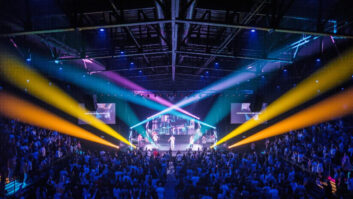
Not surprisingly, the broader architectural community is following in the footsteps of its more elite members, many of whom have moved beyond mere buildings and now aspire to create ambitious artistic statements. For systems integrators, this slow gravitation towards performance art has created exciting opportunities for our industry to help bring the architects’ and lighting designers’ concepts to fruition in new and often breathtaking ways.
So far, the opportunities have materialised at the high-end with the deployment of AV technology in some of the most progressive and exciting architectural projects of recent times. Millennium Park in Chicago, the Danish Industry Confederation’s headquarters in Copenhagen, and the Superdome in New Orleans are great examples of what’s possible when AV integrators, lighting designers and architects collaborate.
The advent of LED technology has given licence to systems integrators, lighting designers and architects to deploy lighting for wash effect, spots or video. With each LED essentially acting as a pixel, a large wall can be transformed into a very large canvas. Couple this advance with the creative use of dynamic lighting — not least moving heads — and the combined impact of architectural inspiration with lighting and AV is extremely exciting.
There are challenges, of course, the weather not the least among them. Imagine the pixel-based large canvas mentioned above, and then imagine the impact of just one light failing due to heat, cold, dust or windblown debris. With the work of systems integrators and lighting designers now on display 24/7, selecting lighting technology that is high performing, reliable and backed by comprehensive support is critical to garnering consistently good reviews.
Obviously, integrating lighting into an architectural design adds equipment and power costs. But many consider empowering the architect to use dynamic exterior lighting to add powerful impact with only limited structural changes. This is particularly true for historically protected buildings or projects involving property where reuse may be complicated by the presence of hazardous materials, which are commonly called brownfield renovation.
It’s up to systems integrators and lighting designers to demonstrate the true value of lighting to partner architects: it significantly enhances their design, helping them achieve more with less. Ensuring lighting is thought of in this way also requires close collaboration with partners in the electrical trade. It’s here that the interaction between performance and construction professionals is most tactile, making relationships based on a mutual understanding of roles, rules and compliance critical to producing excellent work that everyone can be proud of.
In the same spirit, partnering with sustainability officers on the project’s consumption of power is essential to casting the creative execution in a positive light. In recent years, systems integrators and lighting designers have shown our community’s commitment to sustainable systems. Now, as dynamic lighting is being deployed to grand effect on permanent installations, it’s important for sustainability to be an integral element of the architectural design. Co-locating solar cells to power the lighting is a good starting point. Sustainability is also achieved by the use of low-energy systems like LED technology, appropriate control systems and the long-term maintenance of it – where system integrators also play a vital role.
Colour is another important factor. If we consider dynamic lighting to be an addition to the architect’s palette, then colour range, performance and output should be high on the list of priorities for integrators and designers alike. Working with a lighting manufacturer that recognises the importance of colour range and consistent performance is critical to ensuring that the overall visual impact of the work remains true to the original vision. This is as relevant for the main street store and suburban cinema as it is for the high-end gallery or national parliament building.
Like copper domes and glass spires, dynamic exterior lighting is not for every building. Lighting offers the architectural community an opportunity to be more creative and effective. And it’s our industry’s opportunity – if not our responsibility — to ensure that these buildings embody the same stunning level of quality and professionalism as our biggest and brightest performance shows.







